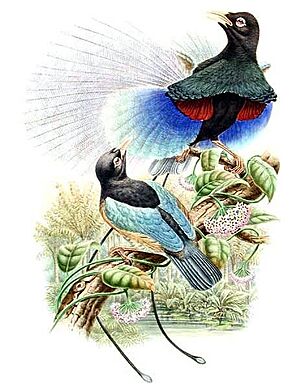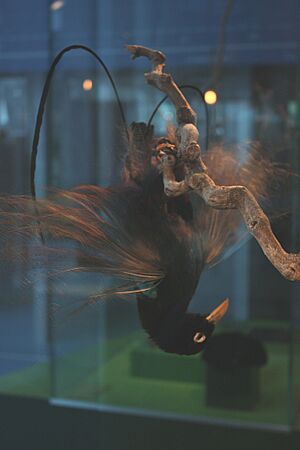Blue bird-of-paradise facts for kids
Quick facts for kids Blue bird-of-paradise |
|
|---|---|
 |
|
| Conservation status | |
| Scientific classification | |
| Genus: |
Paradisornis
|
| Species: |
rudolphi
|
 |
|
| Range of P. rudolphi | |
| Synonyms | |
|
|
The blue bird-of-paradise (Paradisornis rudolphi) is a large species of bird-of-paradise. It is the only species in the genus Paradisornis, but was previously included in the genus Paradisaea.
It is often regarded as one of the most fabulous and extravagant of all birds of the world, with its glorified and fancy flank feathers present only in males and the two long wires also only found in the males.
Taxonomy
The blue bird-of-paradise was formally described in 1886 by the German naturalists Otto Finsch and Adolf Bernhard Meyer. They placed the bird in a new genus Paradisornis and coined the binomial name Paradisornis rudolphi. The genus name Paradisornis combines the Ancient Greek paradeisos meaning "paradise" with ornis meaning "bird". The specific epithet rudolphi was chosen to honour Archduke Rudolf Franz Karl Joseph, the Crown-Prince of Austria. This species was formerly placed in the genus Paradisaea.
Two subspecies are recognised:
- P. r. margaritae (Mayr & Gilliard, 1951) – east central New Guinea
- P. r. rudolphi Finsch & Meyer, AB, 1886 – southeast New Guinea
The blue bird-of-paradise is known to have hybridized with Lawes's parotia (Parotia lawesii), which is called "Schodde's bird-of-paradise", and also with the Raggiana bird-of-paradise (Paradisaea raggiana).
Description

Arguably one of the most fabulous of its family, the blue bird-of-paradise is among the larger birds-of-paradise, being around 30 cm, or a little over a foot in length (excluding the long tail wires), rivaling some of the Paradisaea and Manucodia species. Unlike the Paradisaea birds, the male is mostly glossy black overall with silver-white crescents surrounding the eyes (in both sexes). They have a very crow-like bill that is whiteish to light greyish in colour. The back of the head has a reddish gloss that stretches down to the mantle, or back. A defining feature found in both sexes are the shiny, blue wings that are more commonly light blue but can range from light blue, aqua, or even a skyish-baby blue; the tail is also like this. Stretching from the tail are two blackish and elongated wires with small, whitish spatulate tips similar Paradisaea males' wires. The most brilliant and distinctive feature present on the male are the fine, silky elongated flank plumes that are mainly a dull amber colour on the surface; below, they are a light blue, based by two dark crimson lines on each side of the lower belly. These elegant features help the male create an illusion for his potential audience. The female, however, is more or less similar to the male; of course, she lacks the opulent flank plumes and tail wires present on the male, but she does sport bright blue wings and tail feathers like the male. Instead of having an all-black underside, she is chestnut-brown below with blackish barring. Her head and neck are duller also, with only a faint reddish gloss present. They have purplish-grey legs and feet and greyer claws. The wires on the blue bird-of-paradise are 25 inches long.
Behaviour and ecology
Diet
The blue bird-of-paradise is mainly a frugivorous species, feeding on a good variety of fruits like figs, drupes, and berries, but animal prey is also present in the diet; it not only includes insects, but also some vertebrates like reptiles. They typically feed alone, though females and juveniles are more likely to feed in trees in association with other birds or other species. They are shown to search high in the canopy when seeking fruits and apparently forage at lower altitudes when in search of their animal prey.
Breeding
The male is polygamous and performs a breathtaking courtship display. But unlike most other birds of paradise species, he performs solitary on a preferably thin branch, while an attending female observes nearby. In the display, the male hangs from a branch upside down. The black oval with a red margin at the center of his chest is rhythmically enlarged and contracted. His violet-blue plumes spread out in a fan, looking like an apron, swaying its body back and forth while the black wires form two impressive arches down to either side. During this display, he continuously makes a soft, insect-like buzzing noise, mixed with a chittering or chattering noise to rope the female back in if she moves away.
The nesting and parental duties are covered only by the females; she builds her nest with stems, twigs, palm leaves, vines, and other materials all by herself, usually in a flat cup-like shape. They mostly lay one egg, but two are less occasional, and the mother is very defensive of her brood. The eggs are described to be a salmon-type color, with the ends being ringed with flecks of cinnamon-rufous to tawny.
Status and conservation
Due to ongoing habitat loss, limited range, small population size, and, in some areas, hunting for its highly prized plumes, the rare blue bird-of-paradise is classified as Near Threatened on the IUCN Red List of Threatened Species. It is listed in Appendix II of CITES. Its population is thought to have a decreasing trend, estimated to be anywhere from 2,500 to 10,000 individuals.
Gallery
-
Ventral view of a nominate female specimen. Note its lack of flank plumes and tail wires that the male sports.










